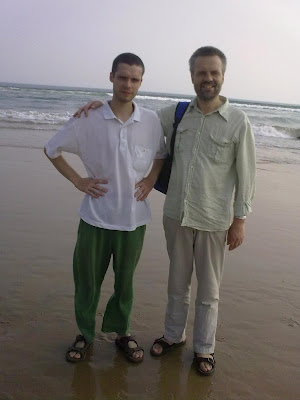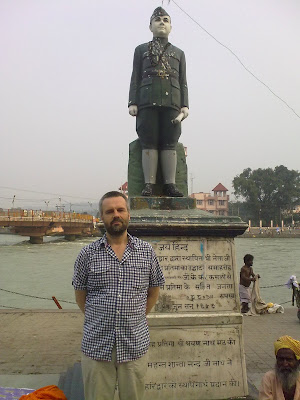For a spiritual practitioner this place is a wonderworld. In the field and hills above the city saints and developed yogis have performed meditation for hundreds and thousands of years. Hence Jamalpur is a highly vibrated place well suited for spiritual pursuits. If you don't know what "a good place for meditation" means it could be likened to the difference bwetween ice cold water and nice warm water for swimmers, or a proper learning environment and a good teacher for education, etc. Anyone who performs sports, arts, etc., at higher levels knows the difference between highly conducive and less helpful environments, and so do those who perform spiritual meditation. Of course, as meditation is inner work it can be performed anywhere irrespective of the immediate surroundings in one's daily life . Anyway, after coming here Erlend suggested we stay on for some days more so that we may properly enjoy the atmosphere as well as the company of the margiis here who had the privilege of knowing Baba intimately. We therefore abandoned our plans for the Rajgir arts festival in order to devote ourselves more to spiritual sightseeing and the company of devotees at Jamalpur.
It is the third time that Trond visits Jamalpur. One thing he noticed this time is how much damage to the environment the mining of the hills in the area have done. Much of the Death Valley and large chunks of the hills at the north end of the field including parts of the ascendence to Kali Pahar (Kali Hill) have been blowed away in recent months and years. Soon the whole landscape may be gone if this large-scale demolition is allowed to continue.
On Sunday October 25 we went into Death Valley as it is called owing to a story of a mass slaughter by one army of another a long time ago. The valley's fearful atmosphere is famous and locals advise against entering the valley after dark -- it is thought to be haunted by the souls of those who were closed in here to meet a cruel death once upon a time. Desolate Death Valley is therefore a favourite place for tantrikas who prefer to meditate in peace at night. We chose early morning as our time of entering and truly enjoyed our walk up through the valley in splendid solitude. Finally a lonely, most natural and unpolluted place in India, teeming with flowers, butterflies and sing-song birds! After first having passed the areas destroyed by mining we came into the other half of the valley, untouched and verdant. Midway we sat in the shade of a big tree for meditation. Out at the other end we were greeted with stunning views of undulating hills and vast agricultural fields to the north-east of Jamalpur, and, to the right of the rear of the valley, breathtaking view of Jamalpur city and its surroundings, much more impressive view than from Kali Pahar. It takes about 30 minutes to walk up Death Valley, an effort richly rewarded with deep silence, calm, natural beauty and the breathtaking view of the Gangetic plain around Jamalpur. Be sure to set aside a public holiday such as Sunday for coming here as weekdays are cordoned off -- and there aren't any street lights to brighten up the nights in this valley.
Atop Kali Pahar
At the mouth of Death Valley when entering from Jamalpur railwaybridge and the lake below Kali Pahar there is a large old tamarind tree that also attracts spiritual interest. It is another most wonderful spot to which we shall return for night meditation.
Under the tamarind tree
As you probably understand by now Jamalpur is something of a fairytale land for the spiritual thirsty. On Saturday we ascended the Kali Pahar for meditation at Baba's spot there and enjoyed the grand views both over Jamalpur town and the interior jungle stretching far into the north. Earlier we had walked on the field beneath the hill where Baba used to go ever so often. Back then it was more of an outskirt, even wild terrain but these days most of the field with the Tiger's Grave and other remarkable spots and tantra piithas has been turned into a golf course! It is surreal to sit down on the grave and on any other spot there to be surrounded by eager golfers who seem to be in dire need of a green card crash course most of them ;)
Tiger's Grave in the field above Jamalpur town
For those of you who have no idea of the "Tiger's Grave" it harks back to the year 1864 when a tiger and an Englishman both died in their mutual clash as a result of their encounter there. The tiger's grave was a favourite sitting place for Baba where he brought many disciples and performed various works. The Englishman's grave is just a few meters away.
The Englishman's grave
The inscription on the Englishman's grave
Nothwithstanding the various encroachments upon the legacy of Baba and other spiritualists of the area, the sweet powerful vibrations of blessed Jamalpur remain very obious to visitors. The Ananda Marga jagrti must be one of the biggest in the world. The spacious meditation hall with its rich accoustics make Sunday Dharmacakra a great experience with around 60 local devotees in attendance. Baba's small room on the original 1950s tiny establishment is the definite place for meditation where very little effort is needed other than closing the eyes.
Accross the street of the jagrti Ananda Marga runs a school with some 75 children.
Too late for admission here
The present principal is Acarya Mantracaetanyananda took very good care of us. We can only recommend margiis to come here regularly. Best times for visiting: September/October to February/March, as the summer months are very hot. When you have arrived be sure to arrange for a guided tour so that you can familiarize yourself with all significant places, like the ones we mentioned, Baba's birthplace, the office where he worked, his living quarters after marriage, the interesting corridor from those quarters to the jagrti, etc., and then have ample time for yourself to enjoy your favourite spots for days and nights together!
Erlend and Acarya Mantracaetanyananda Avadhuta,
Principal of the Ananda Marga Primary School at Jamalpur
Principal of the Ananda Marga Primary School at Jamalpur
Tuesday night we will unfortunately leave Jamalpur for the great arts festival in Varanasi, Shiva's city. So long.





















